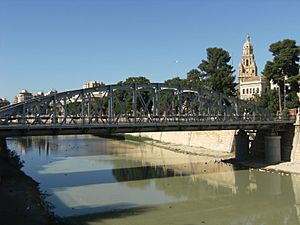Puente Nuevo (Murcia) facts for kids
The New Bridge (or Puente Nuevo in Spanish) is also known as the Iron Bridge (Puente de Hierro). It's a special metal bridge that crosses the Segura River in the city of Murcia, Spain. This bridge was finished in 1903.
It was called the "New Bridge" because it was the second bridge built in Murcia over the river. The first one was the Old Bridge (Puente de los Peligros). Even though it's called "New," it's now the second oldest bridge in the city!
Building the Bridge
A smart engineer named José María Ortiz designed this bridge in 1894. A company from Barcelona called Materiales para Ferrocarriles y Construcciones built it. The project cost about 592,982.95 pesetas. The bridge was fully built and ready on February 21, 1903.
The bridge originally had a long middle section, about 46.8 meters (153 feet) long. It also had eight shorter sections, each about 11.25 meters (37 feet) long. These shorter sections were removed in the 1960s when the river was changed. Only the main, curved middle part of the bridge remains today.
Fixing and Reopening the Bridge
In March 2001, the bridge had to close. It was not safe for cars anymore. The city council of Murcia decided to fix it. They wanted to keep its original look as much as possible.
Because of new safety rules for bridges, it was decided that the bridge would become for people only. It was not strong enough for modern car traffic.
The plan to fix the bridge was led by Javier Manterola in June 2001. After checking everything, the repair work started on July 26, 2002. The bridge was reopened for people to walk across on May 13, 2003.
See also
 In Spanish: Puente Nuevo (Murcia) para niños
In Spanish: Puente Nuevo (Murcia) para niños


